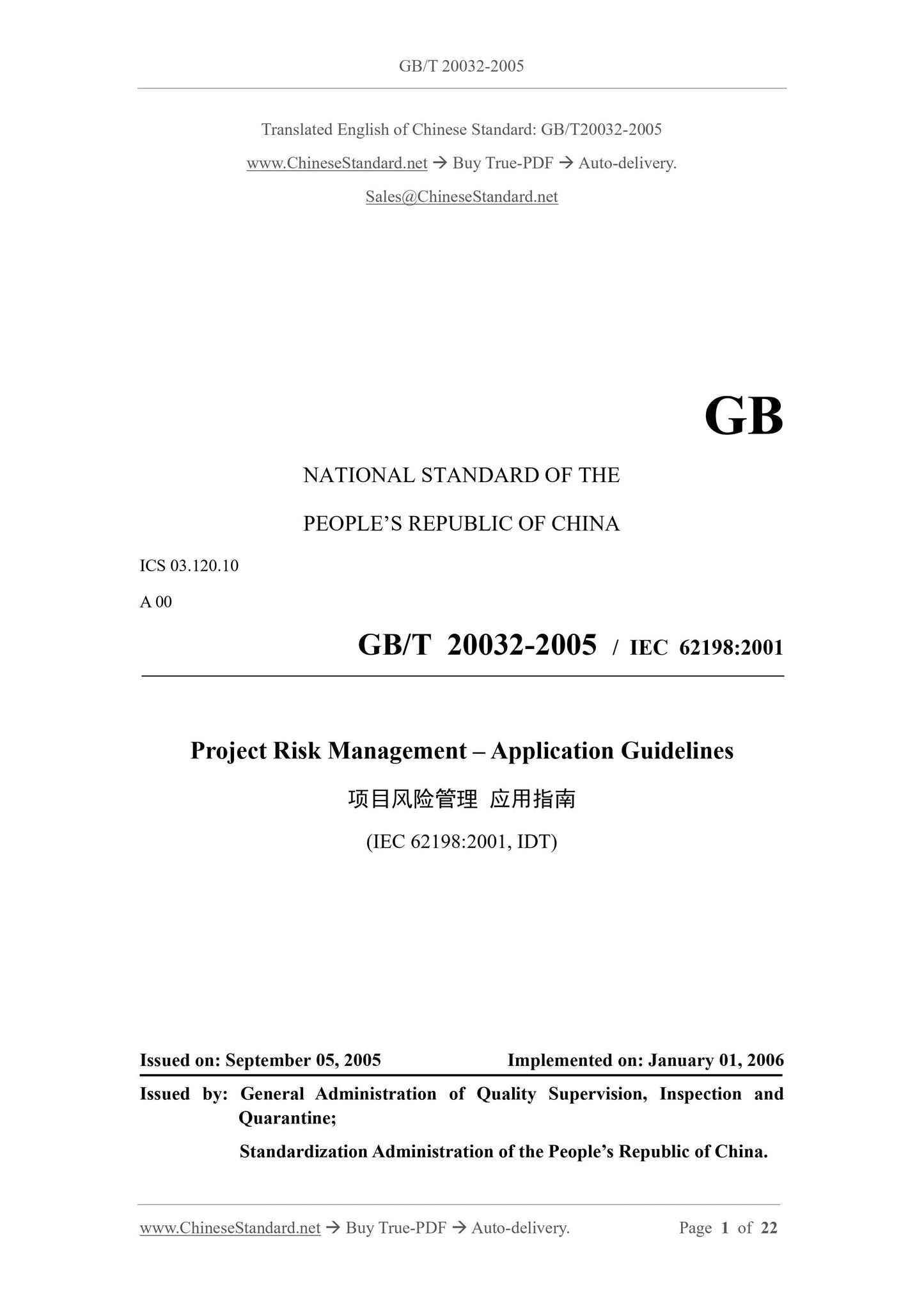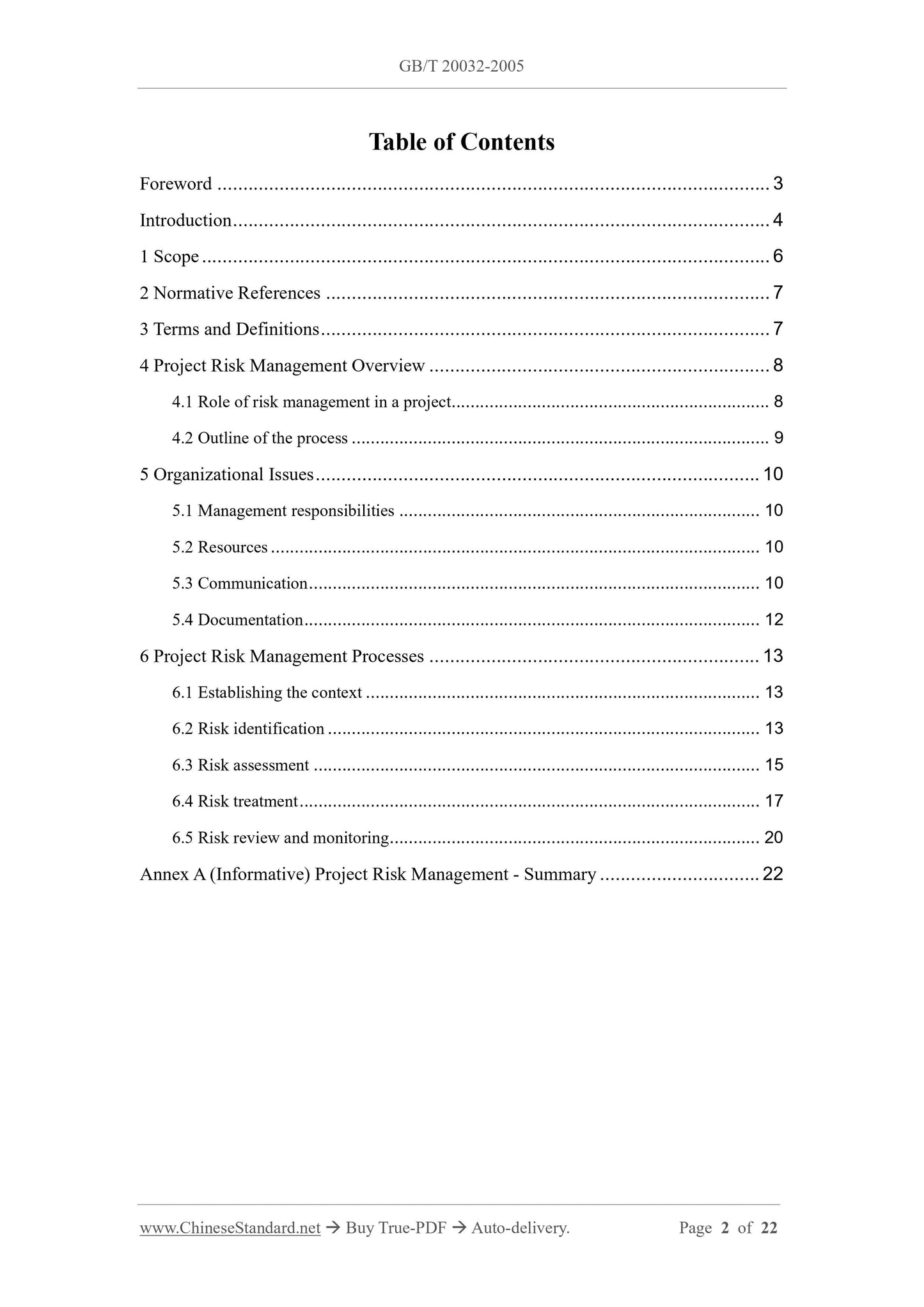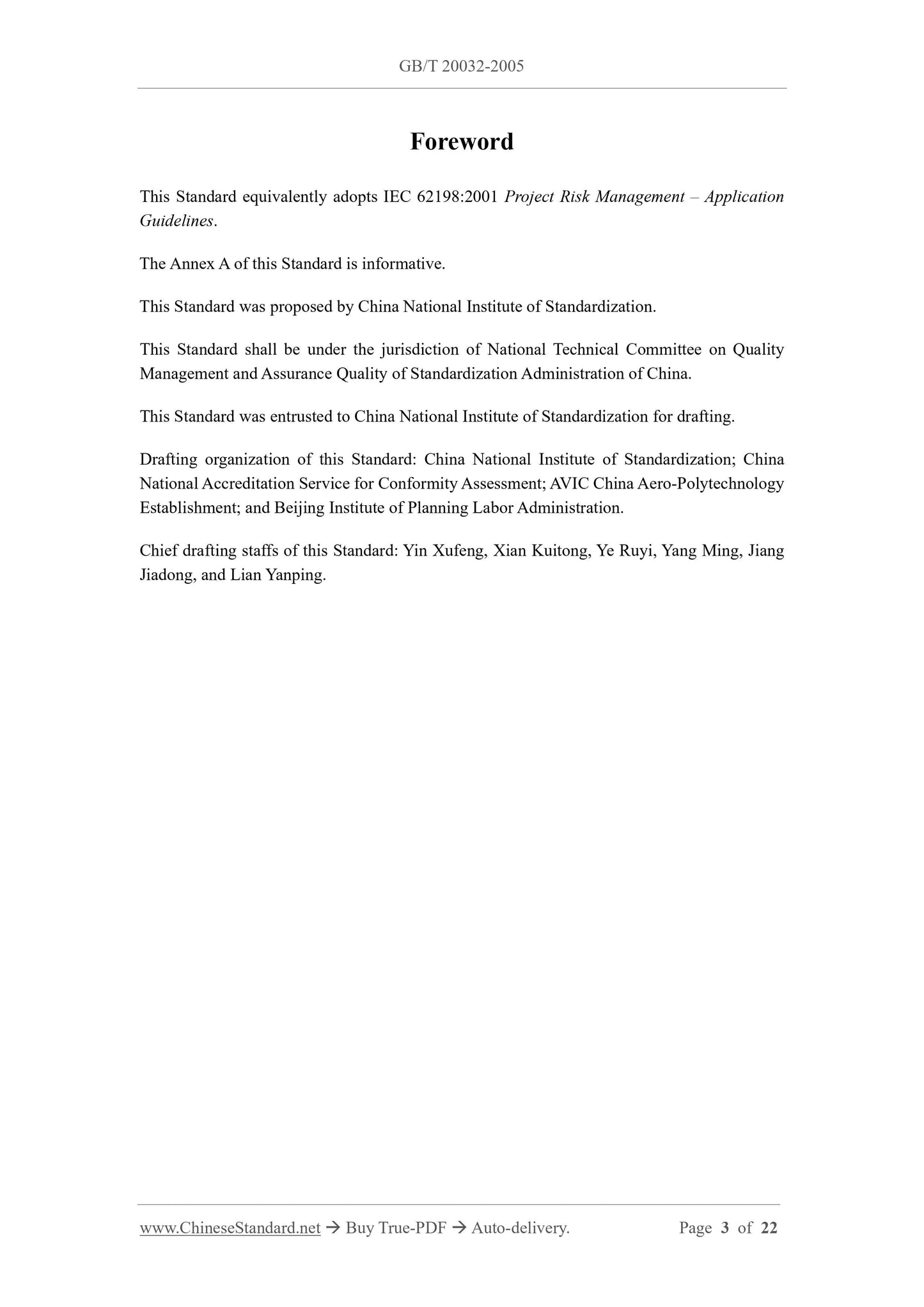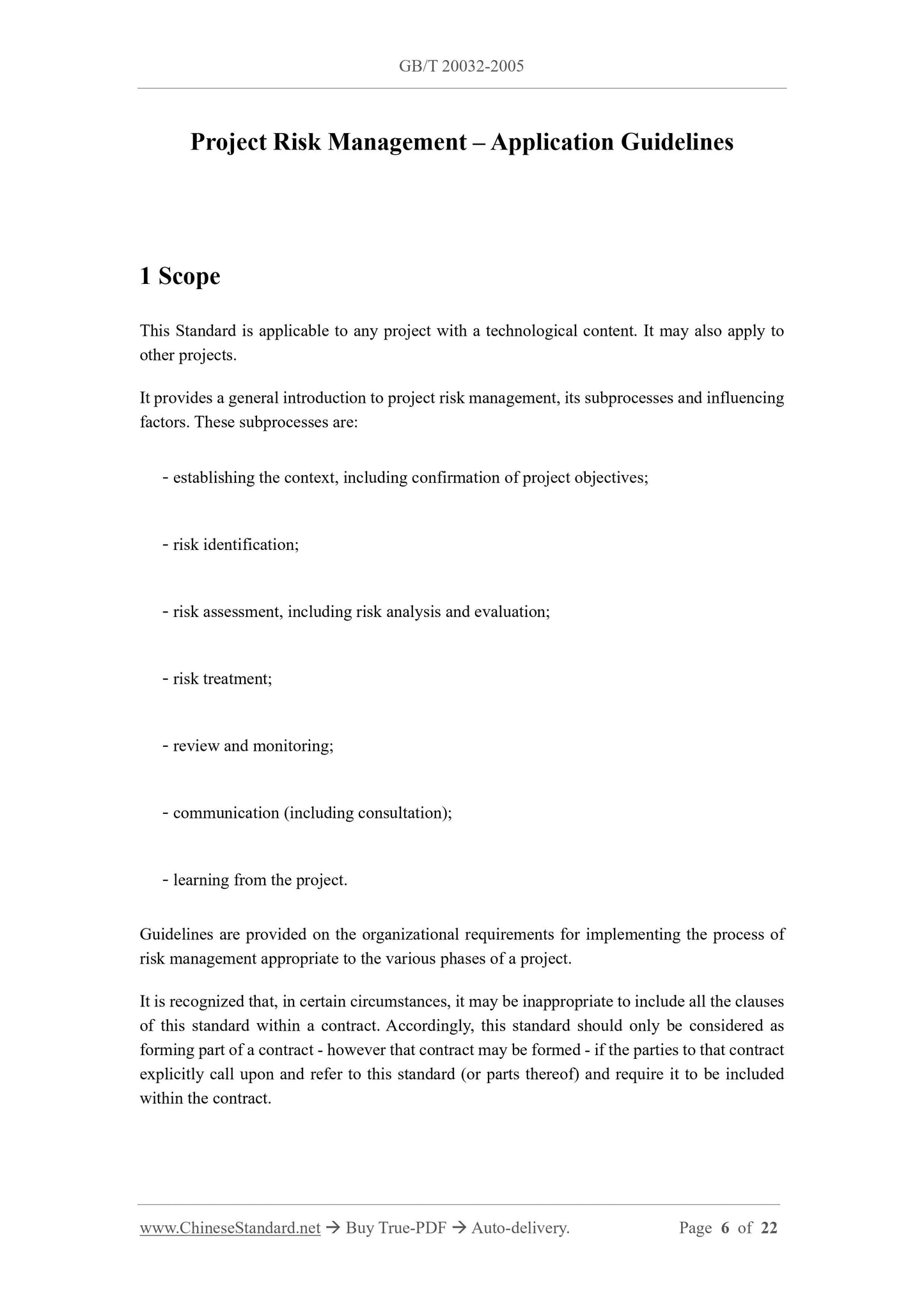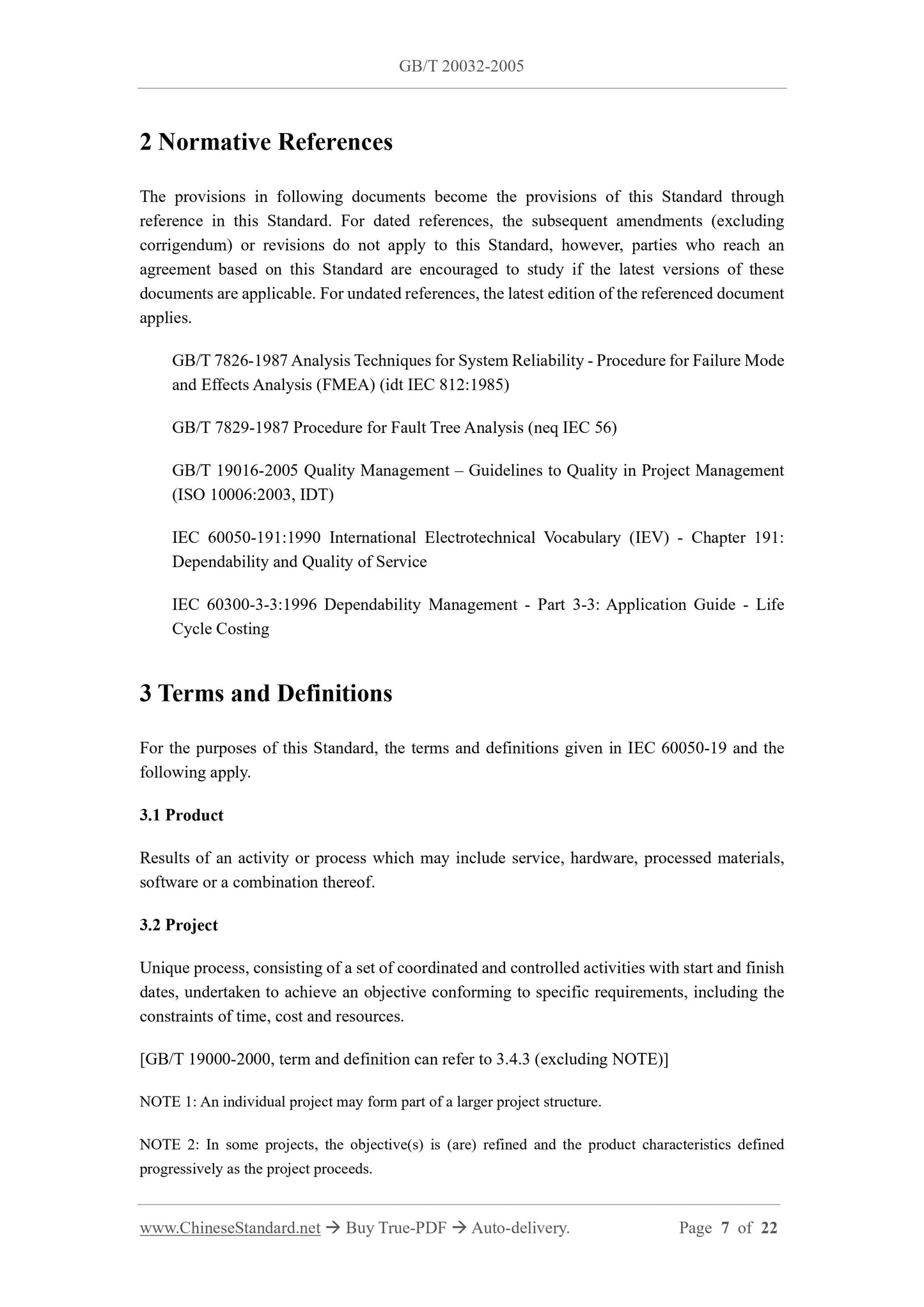1
/
of
5
PayPal, credit cards. Download editable-PDF and invoice in 1 second!
GB/T 20032-2005 English PDF (GBT20032-2005)
GB/T 20032-2005 English PDF (GBT20032-2005)
Regular price
$190.00 USD
Regular price
Sale price
$190.00 USD
Unit price
/
per
Shipping calculated at checkout.
Couldn't load pickup availability
Delivery: 3 seconds. Download true-PDF + Invoice.
Get QUOTATION in 1-minute: Click GB/T 20032-2005
Historical versions: GB/T 20032-2005
Preview True-PDF (Reload/Scroll if blank)
GB/T 20032-2005: Project risk management -- Application guidelines
GB/T 20032-2005
NATIONAL STANDARD OF THE
PEOPLE’S REPUBLIC OF CHINA
ICS 03.120.10
A 00
GB/T 20032-2005 / IEC 62198:2001
Project Risk Management – Application Guidelines
(IEC 62198:2001, IDT)
ISSUED ON: SEPTEMBER 05, 2005
IMPLEMENTED ON: JANUARY 01, 2006
Issued by: General Administration of Quality Supervision, Inspection and
Quarantine;
Standardization Administration of the People’s Republic of China.
Table of Contents
Foreword ... 3
Introduction ... 4
1 Scope ... 6
2 Normative References ... 7
3 Terms and Definitions ... 7
4 Project Risk Management Overview ... 8
4.1 Role of risk management in a project ... 8
4.2 Outline of the process ... 9
5 Organizational Issues ... 10
5.1 Management responsibilities ... 10
5.2 Resources ... 10
5.3 Communication ... 10
5.4 Documentation ... 12
6 Project Risk Management Processes ... 13
6.1 Establishing the context ... 13
6.2 Risk identification ... 13
6.3 Risk assessment ... 15
6.4 Risk treatment ... 17
6.5 Risk review and monitoring ... 20
Annex A (Informative) Project Risk Management - Summary ... 22
Foreword
This Standard equivalently adopts IEC 62198:2001 Project Risk Management – Application
Guidelines.
The Annex A of this Standard is informative.
This Standard was proposed by China National Institute of Standardization.
This Standard shall be under the jurisdiction of National Technical Committee on Quality
Management and Assurance Quality of Standardization Administration of China.
This Standard was entrusted to China National Institute of Standardization for drafting.
Drafting organization of this Standard: China National Institute of Standardization; China
National Accreditation Service for Conformity Assessment; AVIC China Aero-Polytechnology
Establishment; and Beijing Institute of Planning Labor Administration.
Chief drafting staffs of this Standard: Yin Xufeng, Xian Kuitong, Ye Ruyi, Yang Ming, Jiang
Jiadong, and Lian Yanping.
Project Risk Management – Application Guidelines
1 Scope
This Standard is applicable to any project with a technological content. It may also apply to
other projects.
It provides a general introduction to project risk management, its subprocesses and influencing
factors. These subprocesses are:
- establishing the context, including confirmation of project objectives;
- risk identification;
- risk assessment, including risk analysis and evaluation;
- risk treatment;
- review and monitoring;
- communication (including consultation);
- learning from the project.
Guidelines are provided on the organizational requirements for implementing the process of
risk management appropriate to the various phases of a project.
It is recognized that, in certain circumstances, it may be inappropriate to include all the clauses
of this standard within a contract. Accordingly, this standard should only be considered as
forming part of a contract - however that contract may be formed - if the parties to that contract
explicitly call upon and refer to this standard (or parts thereof) and require it to be included
within the contract.
2 Normative References
The provisions in following documents become the provisions of this Standard through
reference in this Standard. For dated references, the subsequent amendments (excluding
corrigendum) or revisions do not apply to this Standard, however, parties who reach an
agreement based on this Standard are encouraged to study if the latest versions of these
documents are applicable. For undated references, the latest edition of the referenced document
applies.
GB/T 7826-1987 Analysis Techniques for System Reliability - Procedure for Failure Mode
and Effects Analysis (FMEA) (idt IEC 812:1985)
GB/T 7829-1987 Procedure for Fault Tree Analysis (neq IEC 56)
GB/T 19016-2005 Quality Management – Guidelines to Quality in Project Management
(ISO 10006:2003, IDT)
IEC 60050-191:1990 International Electrotechnical Vocabulary (IEV) - Chapter 191:
Dependability and Quality of Service
IEC 60300-3-3:1996 Dependability Management - Part 3-3: Application Guide - Life
Cycle Costing
3 Terms and Definitions
For the purposes of this Standard, the terms and definitions given in IEC 60050-19 and the
following apply.
3.1 Product
Results of an activity or process which may include service, hardware, processed materials,
software or a combination thereof.
3.2 Project
Unique process, consisting of a set of coordinated and controlled activities with start and finish
dates, undertaken to achieve an objective conforming to specific requirements, including the
constraints of time, cost and resources.
[GB/T 19000-2000, term and definition can refer to 3.4.3 (excluding NOTE)]
NOTE 1: An individual project may form part of a larger project structure.
NOTE 2: In some projects, the objective(s) is (are) refined and the product characteristics defined
progressively as the project proceeds.
Get QUOTATION in 1-minute: Click GB/T 20032-2005
Historical versions: GB/T 20032-2005
Preview True-PDF (Reload/Scroll if blank)
GB/T 20032-2005: Project risk management -- Application guidelines
GB/T 20032-2005
NATIONAL STANDARD OF THE
PEOPLE’S REPUBLIC OF CHINA
ICS 03.120.10
A 00
GB/T 20032-2005 / IEC 62198:2001
Project Risk Management – Application Guidelines
(IEC 62198:2001, IDT)
ISSUED ON: SEPTEMBER 05, 2005
IMPLEMENTED ON: JANUARY 01, 2006
Issued by: General Administration of Quality Supervision, Inspection and
Quarantine;
Standardization Administration of the People’s Republic of China.
Table of Contents
Foreword ... 3
Introduction ... 4
1 Scope ... 6
2 Normative References ... 7
3 Terms and Definitions ... 7
4 Project Risk Management Overview ... 8
4.1 Role of risk management in a project ... 8
4.2 Outline of the process ... 9
5 Organizational Issues ... 10
5.1 Management responsibilities ... 10
5.2 Resources ... 10
5.3 Communication ... 10
5.4 Documentation ... 12
6 Project Risk Management Processes ... 13
6.1 Establishing the context ... 13
6.2 Risk identification ... 13
6.3 Risk assessment ... 15
6.4 Risk treatment ... 17
6.5 Risk review and monitoring ... 20
Annex A (Informative) Project Risk Management - Summary ... 22
Foreword
This Standard equivalently adopts IEC 62198:2001 Project Risk Management – Application
Guidelines.
The Annex A of this Standard is informative.
This Standard was proposed by China National Institute of Standardization.
This Standard shall be under the jurisdiction of National Technical Committee on Quality
Management and Assurance Quality of Standardization Administration of China.
This Standard was entrusted to China National Institute of Standardization for drafting.
Drafting organization of this Standard: China National Institute of Standardization; China
National Accreditation Service for Conformity Assessment; AVIC China Aero-Polytechnology
Establishment; and Beijing Institute of Planning Labor Administration.
Chief drafting staffs of this Standard: Yin Xufeng, Xian Kuitong, Ye Ruyi, Yang Ming, Jiang
Jiadong, and Lian Yanping.
Project Risk Management – Application Guidelines
1 Scope
This Standard is applicable to any project with a technological content. It may also apply to
other projects.
It provides a general introduction to project risk management, its subprocesses and influencing
factors. These subprocesses are:
- establishing the context, including confirmation of project objectives;
- risk identification;
- risk assessment, including risk analysis and evaluation;
- risk treatment;
- review and monitoring;
- communication (including consultation);
- learning from the project.
Guidelines are provided on the organizational requirements for implementing the process of
risk management appropriate to the various phases of a project.
It is recognized that, in certain circumstances, it may be inappropriate to include all the clauses
of this standard within a contract. Accordingly, this standard should only be considered as
forming part of a contract - however that contract may be formed - if the parties to that contract
explicitly call upon and refer to this standard (or parts thereof) and require it to be included
within the contract.
2 Normative References
The provisions in following documents become the provisions of this Standard through
reference in this Standard. For dated references, the subsequent amendments (excluding
corrigendum) or revisions do not apply to this Standard, however, parties who reach an
agreement based on this Standard are encouraged to study if the latest versions of these
documents are applicable. For undated references, the latest edition of the referenced document
applies.
GB/T 7826-1987 Analysis Techniques for System Reliability - Procedure for Failure Mode
and Effects Analysis (FMEA) (idt IEC 812:1985)
GB/T 7829-1987 Procedure for Fault Tree Analysis (neq IEC 56)
GB/T 19016-2005 Quality Management – Guidelines to Quality in Project Management
(ISO 10006:2003, IDT)
IEC 60050-191:1990 International Electrotechnical Vocabulary (IEV) - Chapter 191:
Dependability and Quality of Service
IEC 60300-3-3:1996 Dependability Management - Part 3-3: Application Guide - Life
Cycle Costing
3 Terms and Definitions
For the purposes of this Standard, the terms and definitions given in IEC 60050-19 and the
following apply.
3.1 Product
Results of an activity or process which may include service, hardware, processed materials,
software or a combination thereof.
3.2 Project
Unique process, consisting of a set of coordinated and controlled activities with start and finish
dates, undertaken to achieve an objective conforming to specific requirements, including the
constraints of time, cost and resources.
[GB/T 19000-2000, term and definition can refer to 3.4.3 (excluding NOTE)]
NOTE 1: An individual project may form part of a larger project structure.
NOTE 2: In some projects, the objective(s) is (are) refined and the product characteristics defined
progressively as the project proceeds.
Share
